#7 real-world examples
Explore tagged Tumblr posts
Text
7 Product Development Examples That Show How Great Ideas Become Reality
Product development is the journey of transforming an idea into a real, usable product that solves problems or improves lives. This infographic showcases 7 real-world examples of successful product development across different industries. From everyday tech to cutting-edge innovations, each example illustrates how creativity, market insight, design, and engineering come together to bring great ideas to life.
Here's a quick overview of each example:
Smartphone – Combines design, software, and hardware innovation to deliver powerful, portable computing in your pocket.
Electric Car – A cleaner alternative to gasoline vehicles, developed through advancements in battery technology and sustainable design.
Food Delivery App – Solves convenience and hunger with real-time logistics, seamless user interfaces, and GPS integration.
3D Printer – Turned a niche idea into a manufacturing game-changer, enabling rapid prototyping and on-demand production.
Streaming Service – Revolutionized media consumption by delivering movies, music, and shows instantly through digital platforms.
Virtual Reality Headset – Brought immersive experiences to gaming, training, and education through advanced sensors and displays.
Wearable Fitness Tracker – Combines sensors and mobile apps to help users monitor and improve their health and activity levels.
Each of these products began as a concept and became a reality through research, development, testing, and iteration proving that with the right approach, great ideas can truly become transformative products.

0 notes
Text




#Best Clinical SAS Training Institute in Hyderabad#Unicode Healthcare Services stands out as the top Clinical SAS training institute in Ameerpet#Hyderabad. Our comprehensive program is tailored to provide a deep understanding of Clinical SAS and its various features. The curriculum i#analytics#reporting#and graphical presentations#catering to both beginners and advanced learners.#Why Choose Unicode Healthcare Services for Clinical SAS Training?#Our team of expert instructors#with over 7 years of experience in the Pharmaceutical and Healthcare industries#ensures that students gain practical knowledge along with theoretical concepts. Using real-world examples and hands-on projects#we prepare our learners to effectively use Clinical SAS in various professional scenarios.#About Clinical SAS Training#Clinical SAS is a powerful statistical analysis system widely used in the Pharmaceutical and Healthcare industries to analyze and manage cl#and reporting.#The program includes both classroom lectures and live project work#ensuring students gain practical exposure. By completing the training#participants will be proficient in data handling#creating reports#and graphical presentations.#Course Curriculum Highlights#Our Clinical SAS course begins with the fundamentals of SAS programming#including:#Data types#variables#and expressions#Data manipulation using SAS procedures#Techniques for creating graphs and reports#Automation using SAS macros#The course also delves into advanced topics like CDISC standards
1 note
·
View note
Text
AI HIGH TICKET COMMISSIONS

#Our advanced AI platform offers automated tools that optimize your sales strategy#ensuring you close high-value deals effortlessly.#By leveraging our AI tools#you’ll not only save time but also increase your conversion rates#allowing you to earn higher commissions without the extra effort.#Perfect for sales professionals#entrepreneurs#and marketers looking to maximize their income and streamline their processes.#‘Since using this AI platform#my commissions have doubled!’ – Sarah#Top Sales Rep.#it’s important to highlight key features and benefits that appeal to potential buyers. Here are some suggestions for how to structure your d#1. **Attention-Grabbing Intro**#- Start with a bold statement or question to capture interest.#- Example: “Unlock your earning potential with our exclusive AI-driven commission program!”#2. **Product Overview**#- Briefly describe what the product is and what it does.#- Example:#3. **Key Features**#- **Smart Analytics**: Utilize data-driven insights to identify your best prospects.#- **Seamless Integration**: Effortlessly connect with your existing CRM and marketing tools.#4. **Benefits**#- Explain how these features translate into real-world benefits.#5. **Target Audience**#- Identify who will benefit most from the product.#6. **Testimonials or Success Stories**#- Include quotes or case studies from satisfied customers.#7. **Call to Action**#- Encourage readers to take the next step#whether it's signing up or learning more.
1 note
·
View note
Text
Scott Pilgrim is, I think, the best example I can think of for establishing a setting's Nonsense Limit. The setting's Nonsense Limit isn't quite "How high-fantasy is this". It's mostly a question of presentation, to what degree does the audience feel that they know the rules the world operates by, such that they are primed to accept a random new element being introduced. A setting with a Nonsense Limit of 0 is, like, an everyday story. Something larger than life, but theoretically taking place in our world, like your standard spy thriller action movie has a limit of 1. Some sort of hidden world urban fantasy with wizards and stuff operating in secret has a nonsense limit around 3 or 4. A Superhero setting, presenting an alternate version of our world, is a 5 or 6. High fantasy comes in around a 7 or so, "Oh yeah, Wizards exist and they can do crazy stuff" is pretty commonly accepted. Scott Pilgrim comes in at a 10. If you read the Scott Pilgrim book, it starts off looking like a purely mundane slice of life. The first hint at the fantastical is Ramona appearing repeatedly in Scott's Dreams, and then later showing up in real life. When we finally get an explanation, it's this:

Apparently Subspace Highways are a thing? And they go through people's heads? And Ramona treats this like it's obscure, but not secret knowledge. Ramona doesn't think she's doing anything weird here. At this point, it's not clear if Scott is accepting Ramona's explanation or not, things kind of move on as mundane as ever until their Date, when Ramona takes Scott through subspace, and he doesn't act like his world was just blown open or anything, although I guess that could have been a metaphor. there's a couple other moments, but everything with Ramona could be a metaphor, or Scott not recognizing what's going on. Maybe Ramona is uniquely fantastical in this otherwise normal world. And then, this happens
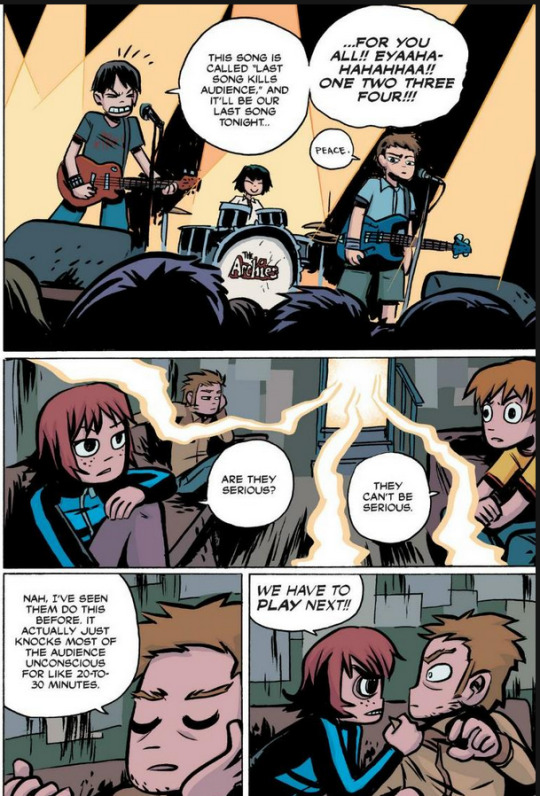
Suddenly, a fantastical element (A shitty local indie band finishing their set with a song that knocks out most of the audience) is introduced unrelated to Ramona, and undeniably literal. We see the crowd knocked out by Crash and The Boys. but the story doesn't linger on the implications of that, the whole point of that sequence is to raise the Nonsense Level, such that you accept it when This happens
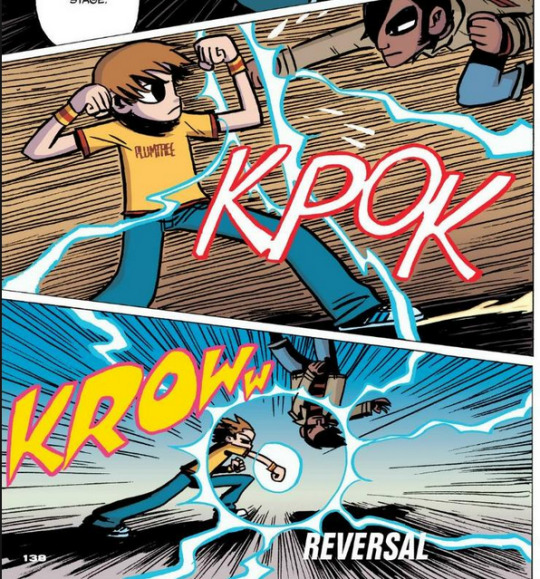
Matthew Patel comes flying down onto the stage, Scott, who until this point is presented as a terrible person and a loser, but otherwise is extremely ordinary, proceeds to flawlessly block and counter him before doing a 64-hit air juggle combo. Scott's friends treat this like Scott is showing off a mildly interesting party trick, like being really good at darts. The establish that Scott is the "Best Fighter in the Province", not only are street-fighter battles a thing, Scott is Very Good at it, but they're so unimportant that being the best fighter in the province doesn't make Scott NOT a loser. So when Matthew Patel shows off his magic powers and then explodes into a pile of coins, we've established "Oh, this is how silly the setting gets". It's not about establishing the RULES of the setting so much as it is about establishing a lack of rules. Scott's skill at street-fighter battles doesn't translate to any sort of social prestige. Ramona can access Subspace Highways and she uses it to do a basic delivery job. It doesn't make sense and it's clear that it's not supposed to. So later on, when Todd Ingram starts throwing around telekinesis, and the explanation we're given is "He's a Vegan" , you're already so primed by the mixture of weirdness and mundanity that rather than trying to incorporate this new knowledge into any sort of coherent setting ruleset, you just go "Ah, yeah, Vegans".
41K notes
·
View notes
Text
i have been in community with profoundly developmentally disabled peers and peers with brain damage my whole life, bc i had a childhood diagnosis. i have also been leftist my whole life; my mother was a marxist and raised me that way, and while their politics were absolute dogshit, they were lefty dogshit.
my entire life, i have seen leftist educators throw mentally disabled people away as "lost causes" because they couldn't engage with the material the way it was being presented. leftist outreach and education does, genuinely, have a massive lack of accessible material. to be blunt, people are not interested in retrofitting their leftist outreach to be accessible to people who learn best through episodes of sesame street.
as in, i have repeatedly faced outright laughter and cruelty over the idea that this could be a priority. or even something that we consider doing at all.
"people who are that mentally disabled don't need to know about these things," the kindest interpretation goes. ("people who are that mentally disabled don't interact with the world, anyway, they're all in institutions or monitored 24/7 by their parents," the uncharitable underlying assumptions go. "they wouldn't be a worker who needs a union. or a library attendee. or a member of the community garden. or a volunteer at the food bank. or or or")
the people i have seen this hurt the worst, over and over again, are profoundly mentally disabled people of color whose lack of access to accessible antiracist education is causing real danger in their lives. institutionalized disabled people of color who have learned racist ideology and behaviors from white authority, whether they were adopted by white families or incarcerated in care institutions run by white staff. who are treated lower than garbage by leftist educators, who view them as "lost causes," as unworthy of time and effort and attention, as deserving of their abuses because they... what... internalized the abuses that make up every aspect of their lives since birth?
i see people saying things in this conversation like "disability isn't an excuse for racism or transphobia or whatever, people have the obligation to improve themselves." oh, believe me, i have seen again and again how many privileged disabled people utilize their disabilities to punch down on others, try to escape accountability for their punching down by citing disability. but individual weaponization of identity is just that: weaponization of identity.
the power structures at play are what they are. it is a noble and admirable goal to want leftist outreach and education to be more accessible to all. if that is truly your goal, you must eventually reckon with the existence of people who do, actually, really need it presented in a picture book. or an episode of bluey. or a conversation where you only use examples of people they know in real life, using things that happened to them personally. the existence of people who cannot grasp forms of abstract reasoning, who need information presented as rules, or as guidelines, or as categories. the idea that yes, fully grown adults who need daniel tiger to explain racism to them are human beings who not only deserve access to that very thing, but who also deserve to be a part of leftist spaces and benefit from leftist organizing. are people for whom it might be INTEGRAL they get to be a part of leftism. are victims of racism themselves and suffering without access to antiracist spaces and community and support.
and you will need to reckon with the abject cruelty of your peers who laugh and mock the very idea of this. you need to reckon with the fact that a lot of people you respect, a lot of leftists doing genuinely good work, will respond to this by making fun of the people you're serving, even outright telling you their violent fantasies about these people. that is the experience of organizing in leftist spaces for profoundly disabled people. that is why so many of us burn out so fast. there IS a structural problem with mentally disabled people being seen as disposable and not a part of community. and it is EXTREMELY present in leftist organizing and outreach efforts.
9K notes
·
View notes
Text
🍖 How to Build a Culture Without Just Inventing Spices and Necklaces
(a worldbuilding roast. with love.)
So. You’re building a fantasy world, and you’ve just invented: → Three types of ceremonial jewelry → A spice that tastes like cinnamon if it were bitter and cursed → A holiday where everyone wears gold and screams at dawn
Cute. But that’s not culture. That’s aesthetics.
And if your worldbuilding is all outfits, dances, and spice blends with vaguely mystical names, your story’s probably going to feel like a cosplay convention held inside a Pinterest board.
Here’s how to fix that—aka: how to build a real, functioning culture that shapes your story, not just its vibes.
─────── ✦ ───────
🔗 Culture Is Built on Power, Not Just Style
Ask yourself: → Who’s in charge, and why? → Who has land? Who doesn’t? → What’s considered taboo, sacred, or punishable by death?
Culture is shaped by who gets to make the rules and who gets crushed by them. That’s where things like religion, family structure, class divisions, gender roles, and social expectations actually come from.
Start there. Not at the embroidery.
─────── ✦ ───────
2.🪓 Culture Comes From Conflict
Did this society evolve peacefully? Was it colonized? Did it colonize? Was it rebuilt after a war? Is it still in one?
→ What was destroyed and mythologized? → What do the survivors still whisper about? → What do children get taught in school that’s… suspiciously sanitized?
No culture is neutral. Every tradition has a history, and that history should taste like blood, loss, or propaganda.
─────── ✦ ───────
3.🧠 Belief Systems > Customs Lists
Sure, rituals and holidays are cool. But what do people believe about: → Death? → Love? → Time? → The natural world? → Justice?
Example: A society that believes time is cyclical vs. one that sees time as linear will approach everything—from prison sentences to grief—completely differently.
You don’t need to invent 80 gods. You need to know what those gods mean to the people who pray to them.
─────── ✦ ───────
4.🫀 Culture Controls Behavior (Quietly)
Culture shows up in: → What people apologize for → What insults cut deepest → What people are embarrassed about → What’s praised publicly vs. what’s hidden privately
For instance: → A culture obsessed with stoicism won’t say “I love you.” They’ll say “Have you eaten?” → A culture built on legacy might prioritize ancestor veneration, archival writing, name inheritance.
This stuff? Way more immersive than giving everyone matching earrings.
─────── ✦ ───────
5. 🏠 Culture = Daily Life, Not Just Festivals
Sure, your MC might attend a funeral where people paint their faces blue. But what about: → Breakfast routines? → How people greet each other on the street? → Who cooks, and who eats first? → What’s considered “clean” or “proper”? → How is parenting handled? Divorce?
Culture is what happens between plot points. It should shape your character’s assumptions, language, fears, and habits—whether or not a festival is going on.
─────── ✦ ───────
6. 💬 Let Your Characters Disagree With Their Own Culture
A culture isn’t a monolith.
Even in deeply traditional societies, people: → Rebel → Question → Break rules → Misinterpret laws → Mock sacred things → Act hypocritically → Weaponize or resist what’s expected
Let your characters wrestle with the culture around them. That’s where realism (and tension) lives.
─────── ✦ ───────
7.🧼 Beware the “Pretty = Good” Trap
Worldbuilding gets boring fast when: → The protagonist’s homeland is beautiful and pure → The enemy’s culture is dark and “barbaric” → Every detail just reinforces who the reader should like
You can—and should—challenge the aesthetic hierarchy. → Let ugly things be beloved. → Let beautiful things be corrupt. → Let your MC romanticize their culture and then get disillusioned by it later.
─────── ✦ ───────
📍 TL;DR (but like, spicy): → Culture is not food and jewelry. → Culture is power, fear, memory, contradiction. → Stop inventing spices until you know who starved last winter. → Let your world feel lived in, not curated.
The best cultural worldbuilding doesn’t look like a list. It feels like a system. A pressure. A presence your characters can’t escape—even if they try.
Now go. Build something real. (You can add spices later.)
—rin t. // writing advice for worldbuilders with rage and range // thewriteadviceforwriters
Sometimes the problem isn’t your plot. It’s your first 5 pages. Fix it here → 🖤 Free eBook: 5 Opening Pages Mistakes to Stop Making:
🕯️ download the pack & write something cursed:
#worldbuilding#writing advice#writeblr#fantasy writing#writing tips#amwriting#writing community#culturebuilding#fiction writing#writing realism#storybuilding#fantasy worldbuilding#speculative fiction#writer resources#writing help#character development#society building#writing immersion#realistic worldbuilding#rin t speaks#thewriteadviceforwriters#writing#writers block#writers on tumblr#writers and poets#on writing#how to write#creative writing#how to start a novel#writing resources
3K notes
·
View notes
Text
Minecrafters Using Reference
Reference as in real world architecture, not other minecrafters' builds, though that's a fair way to learn too. Studying real world architecture gives insights about designing buildings, while studying other minecrafters would give insight into how to accomplish certain effects in Minecraft.
I didn't have more than passing interest in architecture before watching mcyt, but now whenever I'm outside, I'm evaluating the buildings around me. Do I like their shape? color? Any interesting details? Any wear or texture? And above all: How would you do that detail/shape/etc in minecraft? (please note: I don't even play minecraft)
Rendition and Inspiration
There's a minecraft project called BuildtheEarth that's replicating the earth in minecraft on a 1 to 1 scale. There's some fantastic builds on there.
On hermitcraft, Joe Hills is known for creating to scale renditions of real world places/objects. In season 10, he's tackled a project of massive scale with Bell Labs. He used a map from the library of congress to layout all the shapes!


These are examples of renditions/replicas/copies/whatever you want to call it (Although Joe's doubles as a community build area in place of massive parking lots).
Then there's using the buildings for inspiration. This may involve just taking bits and pieces. Or maybe you just take a color palette. Or maybe just the shape. Maybe you don't take anything but vibes. As a general rule, I think having multiple sources of inspiration is important so the new build doesn't end up feeling like a rendition instead of its own thing.
Bdubs in season 9 used the bakery from Kiki's Delivery Service as inspiration for his mud cafe. It can be seen in the wood framing, the stairs, the archway, the shape, the shed, the chimney designs. But the colors, the composition, Bdubs made changes that made it his own and combined the addition to his previous shop Moss o Menos.


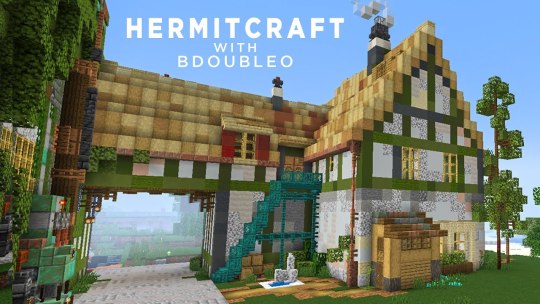
The aesthetics of Geminitay's season 10 base is based on the video game Dredge. I feel like the most obvious influence is in her research castle and fishing boats. She used inspiration from the spooky sea creatures in the game to create a uniquely frightening angler shop.

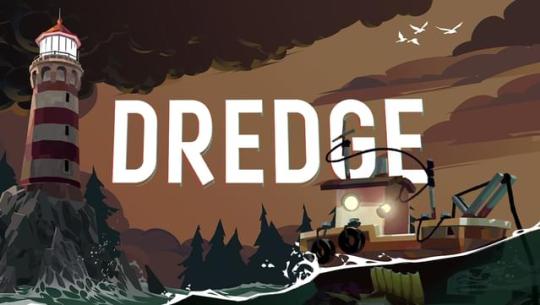
In Pearl's Build a Day series, she did a week focused on real world places. Here's the one she designed after a countryside home in Australia (her home country):


Goodtimeswithscar in season 7, when starting Aqua Town, based his shop on old department stores:


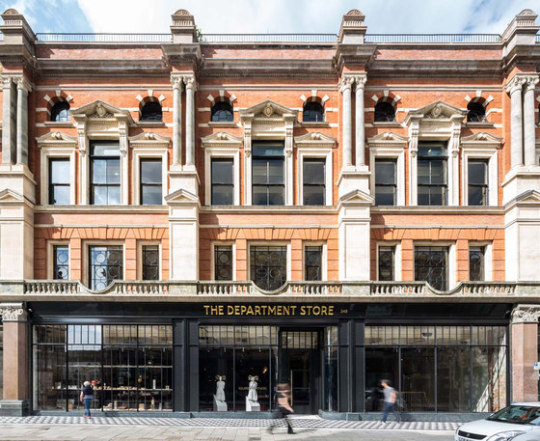
I like looking at his Aqua Town builds in comparison to his Scarland Main Street facades, which draw additional inspiration from Disneyland:





I feel like, comparing the builds you can see how he's grown; he's learned new detailing tricks, found colors and textures that work better with the architecture style. The main street has a similar layout to Disneyland, but his buildings are all unique.
Mogswamp is working on a massive build that's based on architecture drawings from Renzo Picasso:


He's incorporating groin vaults from roman architecture too!
I think builders learning about existing architecture is so good. It can give them so many ideas to add into their toolbox. It reminds them of small details that give builds life, like small sheds, some pipes, porches. And the builds don't need to be realistic; My mind goes to work by Shovel and Joel. Or everything Mumbo has done in season 10.
2K notes
·
View notes
Text
Tips for writing plot twists
1. Start with a false sense of security
• The best plot twists work because the audience feels confident they know what’s coming.
• How? Lay down a trail of clues that mislead without outright lying. Create a sense of inevitability.
• Example: A detective follows all the evidence to one suspect, only for the real criminal to be someone they completely overlooked.
2. Plant the seeds early
• A plot twist is most satisfying when it feels inevitable in hindsight. Subtly sprinkle clues throughout the narrative.
• How? Use small, seemingly insignificant details that take on new meaning after the reveal.
• Example: A side character is always conveniently absent during key events—later revealed to be orchestrating everything.
3. Subvert expectations without betraying logic
• A twist should surprise readers, but it must feel plausible within the story’s framework.
• How? Flip assumptions in a way that feels earned. Avoid twists that rely on coincidences or break the rules of your world.
• Example: A character who appears harmless and incompetent is revealed as the mastermind, with subtle foreshadowing tying everything together.
4. Exploit emotional investment
• Twists land harder when they involve characters the audience deeply cares about. Use relationships and personal stakes to heighten the impact.
• How? Create twists that change how readers perceive the characters they thought they knew.
• Example: The protagonist’s mentor is revealed to be the antagonist, making the betrayal personal and devastating.
5. Use red herrings strategically
• Mislead readers by planting false clues that draw attention away from the real twist.
• How? Make the red herrings believable but not overly obvious. They should enhance, not distract from, the story.
• Example: A mysterious object everyone believes is cursed turns out to be completely irrelevant, shifting focus from the true danger.
6. Timing is everything
• Reveal the twist at the moment it has the most dramatic or emotional weight. Too early, and it loses impact. Too late, and it feels rushed.
• How? Build tension to a breaking point before the twist shatters expectations.
• Example: A twist that flips the climax—when the hero thinks they’ve won, they realize they’ve fallen into the villain’s trap.
7. Allow for multiple interpretations
• A great twist makes readers rethink the entire story, encouraging them to revisit earlier scenes with new understanding.
• How? Design the twist so that the story works both before and after the reveal.
• Example: A character’s cryptic dialogue is recontextualized after the twist, revealing their hidden motives.
8. Pair the twist with consequences
• A twist shouldn’t just shock—it should change the trajectory of the story. Make it matter.
• How? Show how the twist raises the stakes or deepens the conflict, forcing the characters to adapt.
• Example: After discovering the villain is their ally, the protagonist must choose between loyalty and justice.
9. Keep the reader guessing
• A single twist is good, but layered twists create an unforgettable story. Just don’t overdo it.
• How? Build twists that complement each other rather than competing for attention.
• Example: A twist reveals the villain’s plan, followed by a second twist that the hero anticipated it and set a counter-trap.
10. Test the twist
• Before finalizing your twist, ensure it holds up under scrutiny. Does it fit the story’s logic? Does it enhance the narrative?
• How? Ask yourself if the twist creates a moment of genuine surprise while respecting your audience’s intelligence.
• Example: A shocking but clever reveal that leaves readers satisfied rather than feeling tricked.
Follow for more!
#writing tips#writeblr#writing#novel writing#writer stuff#writers on tumblr#writerscommunity#writers and poets#novel#writings#tips#creative writing
2K notes
·
View notes
Text
how to weave subplots into your story without getting tangled in the mess
Subplots: the spicy side quests of your main narrative. They deepen your world, flesh out your characters, and keep things interesting. But if you’ve ever added one and ended up with a story that feels like it’s running in six directions at once… yeah. Let’s fix that.
1. your subplot should serve the main plot
Don’t just throw in a romance arc or a secret sibling reveal because it’s fun (though it is fun). Ask:
- Does this subplot challenge the main character’s goals?
- Does it echo or contrast the main theme?
- Does it change something by the end?
If it’s just a cute side quest with no real impact, it’s fanfic material for your own story. Cool, but maybe not plot-essential.
2. intertwine, don’t parallel
Bad: your subplot exists in a bubble, running beside the plot but never touching it.
Better: your subplot interacts with the main plot. Maybe it complicates things. Maybe it supports the MC in a moment of crisis. Maybe it explodes everything.
Example: your MC is hunting a killer, and the subplot is their failing marriage. Good subplotting means the stress of the hunt affects the marriage, and the marriage affects the hunt.
3. stagger your arcs
Your main plot might hit its midpoint twist at chapter 10. Have a subplot hit a *smaller* emotional beat around chapter 7 or 13. It keeps pacing dynamic and gives your readers something to chew on between big moments.
4. use subplots to develop side characters
Side characters are more than background noise. Give them wants. Give them stakes. Let their stories *collide* with your MC’s. That’s when the magic happens.
5. know when to shut it down
Not every subplot needs a 3-act structure and a dramatic finale. Some are small. Some fade out naturally. Some just shift the perspective enough to reframe the main plot. If you’re tying up subplot #6 with a bow in the epilogue, maybe ask yourself if it really needed to be there.
6. outline the spiderweb
It helps to map out how every subplot connects to the main story. Literally. Draw lines. Make a chaos diagram. It doesn’t have to be neat—just make sure those threads touch.
TL;DR:
Subplots are great. Subplots are juicy. But they’re not decoration—they’re infrastructure. Weave them into the story’s bones or risk writing 3 novels in one.
#writeblr#creative writing#writers#writers on tumblr#writerscommunity#writing community#reading#reader
1K notes
·
View notes
Note
story idea or little short thing which ever but i personally image Natasha being a bad flirt when she really means it, like for example she ends up liking a woman who doesn't work for the Avengers or like has something simple like a small librarian or something and because it's unexpected she doesn't know how to react to this sudden feeling and tries to flirt with her but suddenly every bit of seduction she learnt and she used to her advantage vanished and she just stares a lot and maybe asks about the woman's interest as a way of flirting cause i don't know what to do, she's such a cutie patootie in my eyes, i can take her seriously but at the end of the day i just see my shayla like that's just babygirl with a big heart🥲
How she smiles. | N.R



Warnings: None, just fluff
Word count: 3,7k
A/N: Some story’s aren’t just story’s.
The clock on Natasha’s nightstand blinked 5:42 am. but she was already awake.
The room was still, a minimal space lit only by the soft morning gray leaking through the window. A single shelf held a few books. Her combat boots were lined up with surgical precision at the door. A black hoodie was folded on the chair. No clutter. Nothing personal.
Natasha didn’t need much. She liked it that way. She sat up slowly, letting the silence stretch. It was the one time of day she didn’t have to perform. No missions. No teammates. No masks. Just the hum of a world that hadn’t quite started turning yet.
The floor was cold against her feet. She liked that, too, the reminder that she was real. That she existed in the world, not just above it.
By 6:10, she was jogging along the perimeter of the compound. Not for training. Not for show. Just because she needed it. The steady rhythm of breath and pavement was something she could control.
By 7:00, she was in the gym, alone. No music. Just the sound of fists hitting pads. Her technique was flawless, fast, efficient, unrelenting. She didn’t spar to fight. She sparred to stay sharp.
At 8:00, she changed into a fresh black turtleneck and tailored pants. Not because anyone told her to, but because discipline was a habit she never broke. Breakfast was a protein bar and a black coffee she brewed herself. No creamer. No sugar. No softness.
By 8:30, she was already scanning mission logs in the ops room when Steve walked in, muttering about debriefs and red tape.
“You’re late.” she said, not looking up.
“It’s 8:30.”
“I said what I said.”
He chuckled under his breath. She smirked. It was a rhythm now, their banter, safe, familiar. Maria arrived fifteen minutes later, sleek and pressed as always. Natasha greeted her with a glance, a tilt of the head, just enough suggestion to keep Hill on her toes.
It wasn’t about flirting. Not really. It was about reading people, playing the part they expected. Sometimes that part had a smirk and a raised brow. Sometimes it had a knife. Most people couldn’t tell the difference.
By midday, the team had mostly scattered. Thor was off-world. Tony was buried in his lab. Clint was… somewhere. Natasha didn’t ask. She walked the compound in silence, boots echoing in empty hallways, her reflection catching in polished glass. The world outside buzzed with movement, but inside, there was stillness.
Natasha was many things. Spy, assassin, avenger. But in between all of that, she was also a woman used to waiting. Watching. Living on the edges of other people’s stories. She didn’t mind. It was easier that way.
When she finally sat down with Bruce in the lab around 4:00 pm, it wasn’t about conversation. He handed her a tablet with new intel. She passed him a small container of protein gummies, a quiet joke from their last mission.
“Thanks.” he said, with a hint of a smile.
“Don’t get emotional.” she replied.
Later, it was one of those rare nights when no one was injured, the world wasn’t on fire, and no one was being hunted across continents. So Tony did what Tony did best, threw a party.
The tower’s penthouse was transformed into something between a lounge and a battlefield of banter. Stark had cleared out half the bar’s premium stock. Music pulsed low. Everyone had a drink in hand, but the air wasn’t loose. It was precise, a show of ease from people trained to kill.
Natasha stood near the window, her silhouette painted in city lights, sipping whiskey straight. Her dress was black, high-necked but sleeveless, with a slit that whispered danger.
She was talking to Maria, a shoulder angled just so. A too-long glance. A slow smile that hinted at something unsaid.
Steve stood across the room with Sam and Clint, observing with a raised brow.
“You’re staring.” Sam said, following his gaze.
“I’m…watching.” Steve replied, slowly.
“Same thing.”
Clint smirked and leaned over. “He’s just surprised. Nat’s usually ten moves ahead, but with Hill? She lingers.”
“She’s not doing anything wrong.” Steve said, but his tone was too thoughtful to be casual.
“She never is.” Clint added. “Not where anyone can prove it.”
Meanwhile, Natasha had leaned in closer to Maria, brushing her hand lightly over her sleeve as she made a point about… something she definitely wasn’t listening to. She was flushed.
“Relax.” she said quietly, “I don’t bite.”
Maria gave a nervous chuckle. “That’s…debatable.”
She tilted her head, amused. “Maybe.”
Suddenly, the music dropped, and Tony clapped his hands dramatically. “Alright, children of chaos, time for the real entertainment. Who’s up for a little game?”
Natasha turned toward him, intrigued. “What kind of game?” she asked, already knowing she’d say yes.
“Truth or shot,” Tony said. “Classy, right?”
Groans and laughter broke out. Natasha smiled, finishing her whiskey. “Let’s make this interesting.” she said, walking over to the circle that had started forming in the lounge. “Winner gets to make someone else do anything.”
Steve frowned. “Define anything.”
“Come on, Roger’s.” Natasha said, arching a brow. “Live a little.” She was in control. This was her world. These were the spaces she navigated with elegance and heat and sharpness under the surface.
The morning after was crisp, the kind that bit at the skin but promised a clearer mind. Natasha had been restless since sunrise, her body tense with leftover adrenaline and the ghost of too many thoughts. Steve had caught on.
“You need fresh air.” he’d said. “Come on. Walk with me.” So they walked.
They cut through lower Manhattan in silence, boots clicking on damp sidewalks, the city just beginning to hum to life. Steve talked here and there, about a sparring session with Sam, a report Maria wanted, something about a diplomatic issue in Wakanda, and Natasha nodded, half-listening. Not because she wasn’t interested. Just…tired.
Then Steve pointed across the street. “That place is new.” he said. “Wanna try it?”
Natasha followed his gaze to a corner café tucked between a bookstore and a florist. It had wide windows, soft wood framing, and a handwritten chalk sign on the sidewalk that read:
Red Velvet Latte is back — dare you.
Natasha quirked an eyebrow. “Dare accepted.” The bell above the door jingled as they stepped inside, a soft sound against the murmur of the shop’s early patrons and the low jazz playing through the speakers. It smelled like cinnamon and espresso and something warm.
And then, Natasha froze. She hadn’t meant to. It was just a flicker at first, a glance toward the counter, a tilt of her head. But then she saw her.
You.
A young woman behind the espresso machine, long hair tucked perfectly into a clip, sleeves pushed up, a faint smudge of foam on her cheek. She wasn’t doing anything extraordinary, just pouring steamed milk into a mug, but there was something about her. The way the light caught her jawline. The calm on her face. The quiet confidence in the way she moved.
Beautiful.
Not the kind Natasha usually noticed. Not the dangerous, red-lipped kind. This was so much different. And all at once, Natasha Romanoff, assassin, spy, master manipulator, forgot everything. Steve was still talking, saying something about the furniture layout or the smell of nutmeg, but she didn’t hear a word. Her eyes were locked.
She didn’t even realize she’d stopped walking until Steve gently nudged her shoulder. “You good?”
No answer. Then, like the universe wanted to mess with her, the girl looked up..and smiled. It was instinct that brought Natasha to the counter. Not logic. Not curiosity. Just the kind of invisible pull she couldn’t have described even under interrogation.
“Hi there.” The girl said brightly. “What can I get started for you two?”
Her voice was light, smooth, like honey over gravel. And it hit Natasha like a gut punch. She opened her mouth, but nothing came out.
Steve stepped in, amused but polite. “Just a black coffee for me. She’ll have…” He looked at Natasha. “Natasha?”
Natasha blinked. “I- uh…yes. Sorry. Just…”
The girl tilted her head, waiting. Natasha coughed gently, straightening her posture. “Espresso. Double shot. Please.”
The girl smiled again. “Coming right up.”
Natasha tried to mirror the smile, but it felt off. Too wide. She turned to Steve, who was already watching her with a knowing look.
“What?” she asked, too quickly.
He raised both eyebrows. “You’ve interrogated war criminals with more composure.”
“Shut up.”
They moved to a small table by the window, the sunlight catching Natasha’s cheekbone as she stared into the middle distance.
“You gonna tell me what just happened?” Steve asked, lowering himself into the seat.
“Nothing happened.” she muttered, adjusting the sleeves of her jacket. “I’m just tired.”
“Right.” he said, leaning back with a smirk. “Because I’ve definitely seen you speechless before.”
Natasha glared at him, but she didn’t have the energy to deny it. Her heart was still beating oddly fast, her palms still cool with nerves she hadn’t felt since her first mission.
Across the room, the barista worked with ease, laughing softly with a coworker as she pulled another espresso shot. Her voice carried faintly over the counter, low and melodic.
Natasha didn’t even realize she was staring again.
Steve watched her for a long moment, “Well, damn. I think we found your weakness.”
Natasha looked away, eyes narrowed. “She’s not a weakness.” she said, more to herself than to him. But even as she said it, she wasn’t sure she believed it. Not yet.
Their drinks arrived a moment later, and the girl set Natasha’s cup down gently in front of her.
“I hope it’s strong enough.” she said, and for just a moment, her eyes met Natasha’s. It wasn’t flirtatious. Not overt..Just kind.
And it made Natasha’s throat tighten. She barely managed to say “Thank you.” Then the girl turned and walked away, and Natasha watched her go like she’d forgotten how to do anything else.
Two Days later:
Natasha hadn’t meant to come back. At least, that’s what she told herself. She told herself it was just a convenient detour. She happened to be in the area. She just wanted decent espresso. Nothing more.
But as she turned the corner and saw the familiar chalkboard sign outside, Red Velvet Latte is back. You know you want it. She felt something twist in her stomach. It wasn’t nerves, exactly. It was worse. It was anticipation..
She stepped inside. The café was quieter than the day before, a weekday lull, with soft jazz humming through the speakers and the golden morning light catching on the brick walls. There were maybe five other people seated, heads bent over laptops or books.
And then, there you were. Behind the counter again. Your hair was half-up today, a few strands escaping to frame your face. You looked just as natural, just as quietly radiant as before, and maybe it was because Natasha had replayed the moment in her head too many times, but she felt it instantly:
She remembered you.
You turned, spotted Natasha, and smiled. Not politely. Not like you did for every customer. This one was warmer. Real.
“Oh..” you said, walking toward the register. “You’re back.”
Natasha’s mouth felt dry. You didn’t wait for her to speak. You tapped something into the screen and said, “Espresso, right? Double shot.”
Natasha blinked. Normally, she’d have something ready by now, a teasing remark, a flirty comeback, a raised brow and a smile that said you’re fun, but I’m dangerous. It was a routine. A shield. A game she always won.
But now? Now, she stood there like someone had unplugged her brain. “You…remembered?” she managed.
“Of course.” you said with a shrug, a hint of playfulness in your tone. “You don’t forget someone who looks like they walked out of a spy movie.”
It wasn’t flirtatious, not exactly. But it landed. Natasha opened her mouth, say something, say something clever, say literally anything! But her tongue didn’t move the way it was supposed to.
She gave a breath of a laugh, glancing down at the counter like it had answers. “Well…good memory.” That’s all she had..No wink. No comeback. Just a weird little knot in her stomach and a flush creeping under her collar.
You gave her a curious look, not suspicious, just curious. “You want it for here or to go?”
Natasha should have said to go. She had nothing to do here. No reason to stay. But before her brain could catch up, her mouth said,
“For here.”
You nodded. “Take any seat. I’ll bring it to you.”
Natasha nodded and turned away fast, too fast, choosing the corner table by the window, the one that let her sit with her back to the wall. Habit. Safety. Even if she felt completely unsafe in a way she didn’t recognize. She sat there, pretending to scroll her phone, heart beating in this slow, impossible rhythm.
What the hell was wrong with her?
Across the room, you moved like you belonged there, laughing with a coworker, adjusting the cups, brushing hair behind your ear. Everything about you was normal. So normal. And yet it felt like something had shifted in Natasha’s world just from being near you.
A minute later, you appeared beside her with the espresso. “Here you go.” you said, setting it down gently. “Still hot. I pulled it a little slower this time, more flavor that way.”
Natasha looked up, and for a second, she felt breathless again. She nodded. “Thanks.”
You hesitated. “So…spy movie?”
Natasha blinked. “What?”
“You do look like someone out of one.” you said with a grin. “Mysterious. Sharp jawline. Possibly knows forty ways to kill someone with a spoon.”
Natasha stared at you for a heartbeat too long. Normally, she’d laugh. Play along. Maybe lean in, lower her voice, say something like only forty? But her mouth wouldn’t work right, and instead, all she said was:
“I like spoons.”
Silence. You blinked, then gave a soft laugh that made Natasha’s face burn.
“Noted.” you said, lips twitching with amusement. “Well, enjoy your coffee…Spoon Lady.”
And just like that, you turned and walked away, and Natasha let her head fall into her hands with a groan.
She was losing her mind. Spoon lady? Natasha groaned under her breath, dragging a hand over her face.
She’d survived torture. She’d lied her way out of high-security prisons. She’d faced alien armies and bureaucratic meetings with Tony. And somehow, this was her downfall, a coffee shop and a girl with warm eyes and a smudge of cinnamon on her cheek.
The espresso sat in front of her, untouched. She leaned back in her chair, staring at the tiny porcelain cup like it had betrayed her.
Across the room, you were wiping down the counter, smiling at something a coworker said. Occasionally, you glanced toward Natasha, not obvious, but Natasha noticed. She always noticed.
And she hated that it made her stomach flip.
The café had quieted even more, only two other patrons now, both nose-deep in laptops. The music was softer too, some old soul track that felt like honey poured over late morning sunlight.
It was the perfect window.
Natasha picked up her espresso, stood, and walked, with the casual, predator-smooth stride she used in every hallway, every party, every mission, right up to the counter. To smooth over her earlier embarrassment, reclaim a little dignity, maybe throw in a practiced smile, something casual and clever. To prove to herself that she was still her.
But the second you looked up, all that went out the window.
Not because of how you looked, though, God, you did, but because of the way you blinked when your eyes met, as if startled by your own reaction. The way you tucked your hair back too fast. The way you over-corrected your smile like you didn’t trust it to hold.
She’s nervous, Natasha realized. Not scared. Not intimidated. Just…nervous.
It was adorable. And it knocked the breath right out of her.
Natasha had seen it all, seduction, awe, desire, even fear. But this? This quiet fluster of someone trying so hard to play it cool and failing just slightly? It was real in a way she hadn’t touched in years. No performance. No angle. Just a girl with warm hands, pretty eyes, and the worst poker face she’d ever seen.
Natasha leaned a forearm lightly on the wood and took a sip of her drink, stalling, breathing, reminding herself who she was.
“Okay.” she said, softly but clearly. “That was…a terrible first impression.”
You smiled, eyes bright with amusement. “It was kind of charming.”
Natasha raised an eyebrow. “Is that a polite way of saying I sounded like an idiot?”
“Maybe a little..” you teased, laughing. “But in a very mysterious, highly-trained-assassin-who’s-not-great-at-talking-to-baristas kind of way.”
Natasha shook her head, but smiled. Real this time. She exhaled like it let out something she’d been holding for too long.
“I usually do better than that.” she said, eyes fixed gently on you. “I’m…not sure what happened.”
Your expression softened. You wiped your hands on a dish towel and stepped a little closer, tucking a loose strand of hair behind your ear.
“I think you were just surprised.” you said. “Happens more than you’d think.”
Natasha studied your face for a beat, calm, but flushed, a little shy. And the more Natasha noticed it, the worse she got. Because usually, when someone blushed, she’d lean into it, drop her voice, step a little closer, let the silence stretch. She liked the tension. The control.
But with you?
She didn’t want control.
She wanted to know you.
“I’m Natasha.” she said finally, voice quieter now, like she didn’t want anyone else to hear.
You blinked, that kind of blink that meant oh, and then smiled again, slower this time. “I know.”
Natasha tilted her head. “You do?”
“Yeah…” you admitted, cheeks turning pink, “Steve Rogers was with you yesterday. And you…kind of have the presence of someone who doesn’t do boring for a living.”
Natasha laughed, a low, husky sound. “That’s one way of putting it.”
You stuck out your hand over the counter, suddenly brave. “I’m Y/n.”
Natasha looked at your hand, then took it, her fingers brushing yours just a second too long.
“Nice to meet you, Y/n.” she said. And this time, her voice had its usual rhythm again, low, smooth, a little dangerous. But even then, even with every instinct in her clicking back into place, she didn’t push the flirt further. Not yet.
Instead, she asked, “So…how long have you been working here?”
You smiled, still holding Natasha’s gaze like it was easy. Like you weren’t shaking the world off its axis.
“A little over a year.” you said. “Why, are you planning to become a regular?”
And there it was, the invitation, the challenge. Natasha hesitated for half a second. Then she nodded slowly, smirking just a little.
“Maybe I already am.”
You blinked, your smile faltering slightly, not fading, just shifting. Like you felt the change in the air, too.
“Oh?” you asked softly, setting your rag aside. Natasha’s throat went dry. She glanced down at the counter, then back up. Her voice, when it came, was lower than usual.
“I was wondering..” Natasha said, fingers tapping once, nervously, against the wood, “if maybe you’d want to get coffee with me. Somewhere that isn’t here.”
The words hung there, fragile, quiet, terrifying. You didn’t answer right away. Your lips parted slightly, eyes wide. Then you let out a soft breath, a laugh, the kind people make when something inside them exhales.
“Like a date?” you asked, voice breathless.
Natasha nodded once. “Yeah. Like a date.”
You looked down, then back up, your cheeks flushed, but your smile was real and wide and a little stunned.
“You sure you don’t just want more espresso?” you teased, but your voice was trembling in the sweetest way.
Natasha leaned in, just enough. “I think I’ve had enough espresso. I want…something else.”
There it was. Not a line. Not a performance. Just truth. You bit your lip, still smiling. “Okay.” you said quietly. “I’d like that.”
Natasha blinked once, surprised or relieved. Elated in a way she didn’t know how to show.
Then, gently: “After your shift?”
You nodded. “I get off at two.”
Natasha gave a soft smile, and it reached her eyes this time. “I’ll be here.”
She turned to walk away, and for once, didn’t try to control the smile tugging at her lips. Because this..whatever it was, felt like the start of something she didn’t even know she was allowed to want.
And this time? She wanted everything.
#natasha x reader#natasha romanoff#natasha romanov x reader#dom!natasha x reader#nat x reader#natasha romonova#the avengers#natasha#natasha romanoff x you#natasha romanoff x reader#natasha romanov
966 notes
·
View notes
Text



shifting is EFFORTLESS — and you’ve been doing it all along 🪸✨
. ★⋆. ࿐࿔ ✦ . . ˚ .ੈ✧̣̇˳·˖
you don’t need to force it. you don’t need to chase a specific technique.
you are already shifting — every single moment.
the only difference now? you’re becoming AWARE of it and consciously shifting to a specific reality with the INTENTION of shifting.
. ★⋆. ࿐࿔ ✦ . . ˚ .ੈ✧̣̇˳·˖
🐠✨ shifting is NOT some RARE event or a FARAWAY state you have to earn
you are SHIFTING realities CONSTANTLY. with every choice, every assumption, every moment you decide to step into a reality that aligns with that choice, with that assumption.
for EXAMPLE: when you choose to wear a skirt for the day. you’re now living in the timeline where you chose to wear that skirt today.
another EXAMPLE: if you assume everyone think you’re attractive and irresistible, and you EMBODY that confident, stunning version of yourself, you’re now living in that reality. it’s that simple.
. ★⋆. ࿐࿔ ✦ . . ˚ .ੈ✧̣̇˳·˖
🐠✨ a STUDY that shows how POWERFUL our INNER WORLD is
the kleck & strenta (1980) experiment. in it, people were told they’d have a scar applied to their face so researchers could study how facial disfigurement affects social interactions. they were shown the applied scar in a mirror, but right before the interaction, the makeup was secretly removed. so ultimately, there was NO SCAR. but the participants didn’t know that.
still, they walked into the interaction believing they were disfigured. and guess what? they later said people were rude, distant, or awkward with them. but those reactions weren’t real, they were reflecting what the participants expected to see. it’s such a wild example of how we project, filter, and bend reality based on our beliefs and assumptions.
basically, they were treated the way they thought they’d be, because that’s the LENS they were perceiving their subjective reality through. so when we talk about “reality”, we’re really talking about our individual, SUBJECTIVE INTERPRETATION of it.
it’s like a flow chart: you flow from one reality to the next just by choosing which assumptions you hold true, and which decisions you make that align with those assumptions.
. ★⋆. ࿐࿔ ✦ . . ˚ .ੈ✧̣̇˳·˖
shifting is NATURAL, because you are the chooser.
you are consciousness. you are the soul. you are the one behind the projection (i recently wrote a BLOG about this topic: 🔗 LINK HERE).
and that means shifting doesn’t come from effort, it comes from IDENTITY.
you don’t TRY to shift, you CHOOSE and EMBODY the version of you who already lives there. and the 3D? it follows. it always does.
. ★⋆. ࿐࿔ ✦ . . ˚ .ੈ✧̣̇˳·˖
so take it off the pedestal.
you don’t need to meditate for 7 hours. you don’t need the void (unless you want it). you don’t need to be perfect, emotionless, or “high vibe” 24/7.
you just need to DECIDE that it’s done.
• DECIDE who you are now.
• PERSIST in that identity.
and watch your world re-align.
. ★⋆. ࿐࿔ ✦ . . ˚ .ੈ✧̣̇˳·˖
shifting is always happening. now you get to do it on PURPOSE.
so breathe, let go of the pressure, and remind yourself:
“i’m already shifting. i always have been. i always will be. and i get to choose how.”
. ★⋆. ࿐࿔ ✦ . . ˚ .ੈ✧̣̇˳·˖
🐠✨ SOURCES
Kleck, R. E., & Strenta, A. (1980). Perceptions of the impact of negatively valued physical characteristics on social interaction. Journal of Personality and Social Psychology, 39(5), 861–873. https://doi.org/10.1037/0022-3514.39.5.861
. ★⋆. ࿐࿔ ✦ . . ˚ .ੈ✧̣̇˳·˖
sending so much love and light always <3
#affirm and persist#affirmations#affirming#law of assumption#affirmyourreality#living in the end#loassblog#self concept#affirm and manifest 🫧 🎀✨ ִִֶָ ٠˟#how to manifest#shifting motivation#shifting community#shiftingrealities#shifting blog#shifters#shiftblr#reality shifting#robotic affirming#4d reality#desired reality#neville goddard#void state#law of assumption motivation#law of manifestation#manifestation#loass blog#loassblr#loass success#loassumption#loa tumblr
754 notes
·
View notes
Text
Bragging time!
Yesterday I took my placement tests for college and I got a 990/990 on English, 972/990 on math, and 7/8 on the essay portion!
#the man who gave me my scores said they basically never see perfect scores and a 7 on the essay basically requires an act of God#the essay was on whether fiction can teach us anything about the real world#and I gave pride and prejudice as my principal example#so thank you jane austen 🩷#elly's posts#adventures in college
0 notes
Text
An analysis of the trio of light, their emotions and their cards from book 7
WARNINGS: bias, overthinking, yapping, delulu, spoilers from book 7, personal theories, daydreaming and thousands of other things.

In all of Twst, so far, there are only 3 characters with light magic. These are Rook Hunt, Silver Vanrouge and Kalim Al Asim. And they, in turn, are the only ones who during book 7 won cards with the same element present.
The only sources of light in the game are also the only ones who cry during their cards. Even though in the main story they are not the only ones who cry in moments of stress or relief, Ruggie for example, they are the only ones who have received cards crying.
Initially I found this a curious choice, but the more you analyze it the more you realize that this occurrence comes from how, unlike most characters, these cards reflect the end of an internal arc for them.
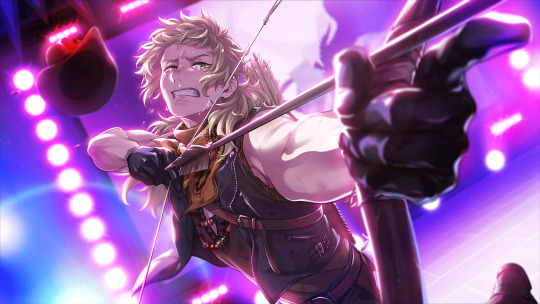
Rook: Throughout book 6, Rook gives hints about how much Vil's overblot affected him psychologically. He talks about nightmares very briefly, and how he still seems stuck in that moment to the point that he risks EVERYTHING to save Vil, even though he knows how irresponsible he is being.
Rook feels guilt, he blames himself completely for Vil's overblot and it clearly haunts him psychologically. It's something that eats away at him, something that is so deep that it even affected his dreams, and that in a twisted way kept Rook far away from Vil in his dream world.
It was this guilt that woke him up, this regret, this sadness, this trauma that haunts him completely. And this is reflected in his card, being the first time we see Rook without his barriers, the guilt, pain and sadness dripping from every expression. He loves Vil, and this pain, the feeling of being a traitor, hurts him more than any arrow.
And it is in this pain that we see Rook's true facet. A boy who loves too much, who feels too much, but who hid it all with his hunter's mask. But as a contemporary poet would say, he is just a man who was making an irrelevant choice but at the same time changed everything.
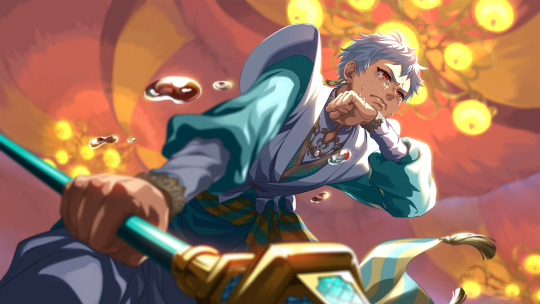
Kalim: In many ways, Kalim carries a toxic positivity. He tries to see the good side of everything and everyone as much as possible, but he constantly ignores his own discomfort or completely negative emotions.
What is not good, what is not healthy, the way Kalim lives in eternal denial and always suppressing EVERYTHING inside himself.
Until he became furious. In that dream, with that version that practically mocks Jamil, Kalim found himself completely irritated and disgusted. Angry at himself, angry at Malleus and angry at everything that had happened before. It is in this anger that Kalim finally fully computes the events of book 4, it is in this anger that he understands his own feelings and those of others.
He cries because he is frustrated, angry and tired. He cries for everything he has been through, for everything he has been denied, and he cries because it was all stupid and unfair. Kalim, who constantly smiles and brings joy, for the first time is completely tired of the fake smiles and his own denial of reality. Smiling would not change his and Jamil's situation, smiling was not helping him at all.
From a passive smile to determined anger.

Silver: The only one of the three whose tears did not come from stress or frustration, but from pure and genuine relief.
Unlike the others, Silver has always had difficulty showing what he feels. It is said several times that people cannot tell what he is feeling. He has always been different from the others because of this.
"Too human for the fairies."
"Too fairy for humans."
This is actually a very present theme in Silver's narrative, and during book 7 the human factor is put in his face as a doubt. A doubt about Lilia's love and his place by Malleus' side.
At every moment the need to choose, to hide a past he never knew, to discover what his real role is in the narrative of this story. Is he the knight in shining armor who will kill the monster? Is he the prince of an enemy kingdom, who will once again make the same mistakes as his father? Is he one of Malleus Draconiana's followers, trying his best to save his prince from himself?
And the answer? He is Silver Vanrouge, son of Lilia Vanrouge and brother of Malleus. He is not a prince or a knight, he is a brother, a friend and a son. He, who managed to save the people he loved so much, cries with joy and relief for this.
Silver reached his happy ending, surrounded by people who loved him as much as he loved them. People who could not care less where he came from, because the fact was clear who he was.
He was Lilia's little boy, who would fall asleep anywhere spontaneously and unexpectedly.
He was Malleus' little brother, who always smiled in his presence and who always wanted to stay by his side.
He was Sebek's rival, who grew up together both in power and internally. The one who would be by his side, both with the same dream and desire.
They all cry for the same reason, as they have finally finished their stories.
The hunter is still loved by the queen, as she never saw his actions as a betrayal.
The sultan and the sorcerer finally understand each other, they finally understand that they complement each other and do not depend on each other. And together, they can achieve freedom.
The little soldier can now finally smile with relief, as he has finally acquired proof that he has a home to return to.
Simply beautiful, don't you agree?
#twisted wonderland#twst#twst wonderland#disney twst#kalim al asim#rook hunt#silver vanrouge#silver twst#character analysis#analysis#yapping#deep down#thoughts
589 notes
·
View notes
Text
How to Craft a Compelling Morally Grey Character: A Step-by-Step Guide
Step 1: Define the Character’s Core Traits
Identify Strengths and Virtues: List positive traits that make the character likable or admirable. These could include bravery, intelligence, loyalty, or compassion.
Identify Flaws and Vices: List negative traits that add complexity and realism. These could include arrogance, selfishness, impatience, or a propensity for violence.
Step 2: Establish Motivations and Backstory
Create a Detailed Backstory: Develop a background that explains why the character has their particular mix of virtues and flaws. Consider their upbringing, significant life events, and personal experiences.
Determine Core Motivations: Identify what drives the character. Is it revenge, love, ambition, survival, or something else? Motivations should be realistic and relatable.
Step 3: Develop Moral Ambiguity
Set Up Moral Dilemmas: Place your character in situations where they must make difficult choices with no clear right or wrong answer. These dilemmas should challenge their morals and reveal their complexity.
Showcase Contradictions: Allow the character to make decisions that might seem contradictory. For example, they might commit a crime to protect someone they love, revealing both a moral and an immoral side.
Step 4: Create Dynamic Relationships
Construct Meaningful Relationships: Develop relationships with other characters that highlight different aspects of your morally grey character. These relationships can help explore their multifaceted personality.
Use Relationships to Drive Conflict: Relationships can be a source of moral conflict and development. Conflicts with friends, family, or rivals can push your character to reveal their grey areas.
Step 5: Show Consequences and Growth
Illustrate the Impact of Actions: Show the real-world consequences of the character’s morally ambiguous decisions. This adds realism and stakes to the story.
Allow for Character Growth: Let your character evolve. They might become more virtuous or more corrupt over time. This evolution keeps the character dynamic and interesting.
Step 6: Balance Sympathetic and Unsympathetic Traits
Make Them Relatable: Ensure the character has traits or experiences that the audience can relate to or sympathize with, even if they do questionable things.
Maintain Complexity: Avoid making the character too sympathetic or too unsympathetic. The balance between good and bad traits should make the audience feel conflicted about the character.
Step 7: Use Subtlety and Nuance
Avoid Clear Labels: Do not overtly label the character as good or evil. Allow their actions and motivations to speak for themselves.
Employ Subtlety: Use nuanced behavior and dialogue to reveal the character’s moral complexity. Avoid heavy-handed exposition.
Step 8: Test and Refine
Seek Feedback: Share your character with others and seek feedback on their complexity and believability. Adjust based on constructive criticism.
Refine Motivations and Actions: Continuously refine the character’s motivations and actions to ensure they remain compelling and consistent throughout the story.
Example: Crafting a Morally Grey Character
Core Traits:
Strengths: Intelligent, determined, loyal.
Flaws: Arrogant, manipulative, vengeful.
Backstory:
Grew up in a tough neighborhood, witnessing crime and corruption.
Lost a loved one to a gang, fueling a desire for revenge.
Motivations:
Driven by a need to protect their remaining family and seek revenge.
Moral Dilemmas:
Joins a criminal organization to infiltrate it and bring it down from within.
Struggles with the ethical implications of committing crimes for a greater good.
Relationships:
Has a strained relationship with a sibling who disapproves of their methods.
Forms a complicated friendship with a morally upright police officer.
Consequences and Growth:
Faces the legal and emotional consequences of their actions.
Gradually questions their own morality and seeks redemption.
Balance:
Helps the community but uses unethical means.
Shows moments of kindness and ruthlessness.
Subtlety:
Reveals their inner conflict through small actions and dialogue.
Avoids overt explanations of their morality, letting the audience interpret.
By following these steps, you can create a compelling morally grey character that adds depth and intrigue to your story.
---
+ If you find my content valuable, consider Support This Blog on Patreon!
#writing tips#writing advice#character development#writers on tumblr#writeblr#creative writing#fiction writing#writerscommunity#writing#writing help#writing resources#ai assisted
2K notes
·
View notes
Text
Treasure hunt, finding things around you
Here's an assignment, only for anyone who feels like doing it. In the month ahead, by the start of February, find as many of these things as you can or choose to. Photos or not photos as you prefer. These aren't to be submitted to me but are just a kind of treasure hunt for you to write down or keep in a notes app. 1. Moss, as many kinds as you can find. 2. Lichen, 3 colors. This is fun because it can be on buildings and things like curbs, grave stones or monuments. 3. 3 or more kinds of birds, extra points for different types like songbirds vs. ducks and geese vs herons or other stalking birds. Yes, pigeons count. 4. 3 kinds of trees you can tell apart, evergreens or ones that are leafless now.
5. One beautiful sunrise or sunset. 6. If you're in a place that gets cold, 2 kinds of ice, like icicles and puddle ice would be 2 kinds for example. If you're not in a cold place then interesting water things like a puddle with oil colors in it or drops of dew on grass or a flower. 7. 3 kinds of weather. This one's easy. Maybe pictures of a sunny or partly cloudy sky and a dark cloudy sky and maybe a picture of trees or flags being blown by wind.
8. Any animals. They're things like Pokemon but in the real world. lol Yes squirrels count. Rats do too. 9. Stand in 3 kinds of places, for example by a stream or river, high on a hill—that can be in a city or in the country. Pittsburgh for example has some great hills. San Francisco too. If you're at Oberlin maybe you can find a pile of dirt haha—and third, maybe a public space like a plaza or a town circle or if you're in the country then just an especially nice spot along a road or trail. 10. Finally, look for any especially nice or beautiful scene around you, whether it's frost on a plant in the sunlight, a beautiful window you pass in the evening (taking pictures of people without permission especially through a window is rude so try to avoid that), ice on a car window or any scene or tiny thing that just catches your eye in a pleasing way. A beautiful tree, a beautiful sky, a cute cat, whatever.
And of course if you find cool or interesting stuff not mentioned here, that's extra credit. :-) If you see something really good you can tell me about it and if you feel like letting me know how it went at the end I would be interested to hear from you. I know some of you already look for this stuff. Take this as a little extra encouragement. Maybe when you post things from this list, use the tag #noticing stuff. Or does someone have a better tag for it?
1K notes
·
View notes
Text
Why Does Physical Change Literally Happen?
{+1 explanation for the logical part of the brain}
“Will I just be pretending to myself?” “What is the logic in changing my current unwanted body for what I want to be and how others see me and this change?”
Some questions that go through our heads when we talk about manifesting the desired appearance, and this is normal. Let's demystify this and be absolutely sure to manifest more easily and quickly.
First no, you are not “faking it to yourself.” What you are doing is a process of mental self-reprogramming that uses the power of the mind to create a new internal reality, which will inevitably be reflected on the outside.
1. The Mind Doesn’t Distinguish Between Reality and Imagination
When you intensely imagine your desired body, your brain acts as if it were already true. It begins sending signals to your body to align your physiology with this new vision. This isn’t “faking it,” it’s literally reprogramming your system.
2. How Does Physical Change Literally Happen?
Your body is run by your brain. Everything it does—from regenerating cells to changing its structure—responds to instructions that you, consciously or not, send it. When you see yourself as the version of yourself you want to be, you are literally reprogramming your brain to create that physical change.
Examples in Science and Biology:
• Epigenetics: Your thoughts influence which genes are “turned on” or “turned off.” If you internally assume the identity of a person with the desired body, your body begins to align with that identity.
• Neuroplasticity: The brain reorganizes itself based on the beliefs you hold. It can change hormonal patterns, metabolic patterns, and even cellular regeneration to adapt to what you believe to be true.
3. Why Does Physical-Touchable Reality Change?
• Assumed Identity: When you believe that you already have the desired appearance, the body begins to respond with real physiological changes. For example, a mental model of “I am thin” can change hunger patterns and metabolism, while “I am young” can stimulate collagen production.
• Instructions to the Subconscious: The subconscious controls automatic functions of the body, such as cell regeneration and fat distribution. It accepts everything you imagine with emotion as absolute truth.
4. How Others See You
People see you through the energy and confidence you exude. If you are aligned with the feeling that you are already who you want to be, others will automatically begin to treat and see you that way.
• They may not know “how” or “when” you changed, but they will notice that something is different. This is because your self-confidence and inner congruence have a direct impact on social interactions.
5. You’re Not Pretending, You’re Choosing
When you decide that you are already the desired version of yourself, you’re not pretending, you’re taking on a new identity. This is a conscious exercise in creating the reality you want, and 3D has no choice but to reflect that decision.
6. Real-World Example to Make It More Concrete
1. People who underwent hypnosis believing they had real burns on their skin developed physical blisters—because their bodies responded to their minds.
2. Patients in placebo studies who “believed” they were taking a rejuvenation drug experienced real physical changes, such as improved skin and organs.
These are extreme examples, but they show that the mind instructs the physical body, and the body obeys. It’s not symbolic or “just in the imagination”—it’s a transformation that manifests itself in the tangible.
7. How to Make This Transformation Solid and Firm
To truly believe that your physical transformation is happening:
• Decide and Feel: “I already have this.” See your body as what you want, not what you “think it is.”
• Visualize Clearly: Imagine what it would be like to touch, see, and live with this body. Not just mentally, but as if it were already a reality.
• Believe in Inner Logic: Whatever your mind accepts as truth, your body will do. If you have assumed this new identity, your body has no choice but to follow.
It’s not pretending, nor is it wishful thinking. It’s using the power of your mind to literally transform your body into something physical and real.

#law of assumption#loassumption#loa tumblr#manifesting#loa blog#neville goddard#loass#loa#manifestation#law of manifestation#loass success#loass states#loassblog#loa success#loablr#loass post#loass angel#loassblr#loass tumblr#living in the end#live in the end#assume and persist#affirm and persist#fairyminnie444#desired life#desired reality#desired appearance#shiftinconsciousness#shifting motivation#shifting community
510 notes
·
View notes